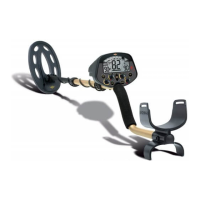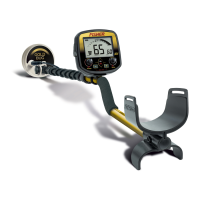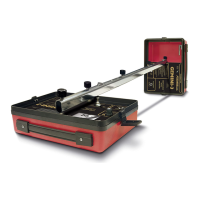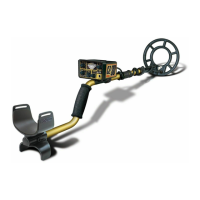DISCRIMINATION MODE (continued)
NOTCH
Unlike Discrimination Level, which eliminates all targets from the left of the scale to the right,
NOTCH can eliminate and re-include targets within the scale displayed at the top of the display.
Inclusion or exclusion of target ranges is indicated with a half-crossed or crossed icon.
To demonstrate how to set a notch, follow this instruction at first use.
1. Reset all detector values to default:
a. turn detector off
b. press-and-hold red MENU button and push-forward-and-hold Toggle
switch
c. turn detector on while continuing to hold MENU and Toggle
d. release Menu and Toggle.
2. Press MENU button 4 times to move down to the NOTCH feature
-then rotate the SETTINGS knob to the right until the number 40 appears.
-then press MENU again to accept this notch value.
3. Notice that a thin line appears across the word “TAB” printed on the top of
the display.
4. Press MENU again to exit the NOTCH feature.
5. Targets in the first ½ of the TAB range (TAB range is from 36 to 55) will be
eliminated from detection.
6. A half-slash will be permanently displayed across the top-left of the word “TAB.”
NOTCH allows you to select target ranges equal to ½ of each category for inclusion or exclusion
from detection. As you rotate the knob, the target indicator will appear above the range currently
selected. If you set the notch value anywhere within the range, the notch value will not necessarily
stop at this number, notch ranges are fixed as follows:
1. 1 -7 iron 6. 31-35 nickel
2. 8-15 iron 7. 36-45 tab
3. 16-20 foil 8. 46-55 tab
4. 21-25 foil 9. 56-60 zinc
5. 26-30 nickel 10. 61-65 zinc
The following are characteristics of NOTCH programming:
• As you rotate the knob to enter a notch range, the target indicator block at the
top edge of the screen illuminates to show you the range you are in.
• After you have selected a notch, a slash is illuminated over that range, indicating
that all targets within that range (see chart above) are eliminated from detection.
• When you enter the program to make a change to the notch settings, you are
changing the status of the notch. If no slash is illuminated and you press
MENU to set a notch range, you will be notching-out this range. If a slash was
previously illuminated and you press MENU to set this notch range, you will be
notching-in this range.
• Programming a notch range always reverses the status of the notch.
Using DISC LEVEL in conjunction with NOTCH gives you a great deal of flexibility in deciding
which values to include or exclude from detection. Beware that this combination can be confusing.
Here are some examples of NOTCH used in conjunction with DISC LEVEL
If Discrimination Level is set at 60, and you set the top-of-foil (21-25) notch between 21 and 25,
then: top-of-foil range (21-25) is NOTCHED-IN (i.e. detected)
If Discrimination Level is set at 23, and you set the top-of-foil (21-25) notch between 21 and 25,
then: 21, 22, & 23 are NOTCHED-IN. 24 & 25 are NOTCHED-OUT
If Discrimination Level is set at 15, and you set the top-of-foil (21-25) notch between 21 and 25,
then: 21-25 are NOTCHED-OUT
